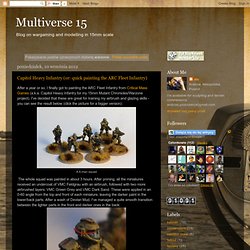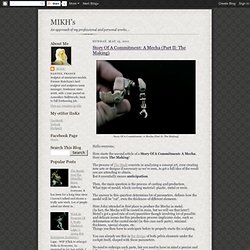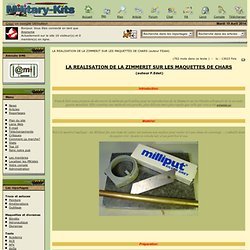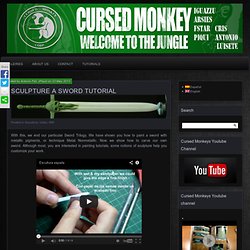

Warzone. Just to give you an idea of what looks I have in mind for my upcoming Etoiles Mortant - a quick update on where I am with the conversion work.

In case you didn't come across WarZone or Mutant Chronicles - the Etoiles Mortant ('Dying Stars') is an all-female unit in the army of Bauhaus corporation. They are primarily close-assault unit, wielding swords and pistols, with support options limited to weapons such as light flamethrower or some grenades. Here's how the original 28mm Etoiles Mortant look: I use Black Widow Mercs as a base for my conversions - as you can see below, they resemble the original look at some points (jumpsuit, pistol, hairstyle, shoulder pads.
I decided there are three features of the original look that I would like to add: combat boots (the idea of jumpsuit merged with the boots didn't really appeal to me), belt and webbing (to break up the looks of the jumpsuit a bit) and - of course - the swords. And here... Trench 2114. - Home. Story Of A Commitment: A Mecha (Part II: The Making) Hello everyone, Here starts the second article of a Story Of A Commitment: A Mecha.

Here starts The Making! The process of The Study consists in analyzing a concept art, even creating new arts or designs if necessary as we've seen, to get a full idea of the result you are attending to obtain. But it essentially means anticipation. Then, the main question is the process of casting and production. The answer to this question determines lot of parameters, defines how the model will be "cut", even the thickness of different elements. Here John attended in first place to produce the Mecha in metal. You can already see this in the design of both pelvis elements under the cockpit itself, shaped with these parameters. No need to redesign each parts, but you need to have in mind a precise and full picture of them and how you will manage them.
This also will help you to decide other parameters such as the medium or putty you will use, and then the type of sculpting and the tools you will need. ... ... Pigments. La figurine sous tous les angles. Metallic_color_comparison_chart.jpg (Image JPEG, 1200x7074 pixels)
Neige et cristaux. LA REALISATION DE LA ZIMMERIT SUR LES MAQUETTES DE CHARS (auteur F.Edet) La première chose à faire : préparer la surface qui va recevoir le mastic afin de lui donner une bonne adhérence, on commence en ponçant avec du papier à gros grains.

Je refais de grosses rayures en quinconce pour donner encore plus d’accroche au Milliput. On rentre dans le vif du sujet : deux boulettes de même taille sont séparées de leurs tubes respectifs. La plaque est préparée avec du talc. On les malaxe ensemble jusqu’à obtention d’une couleur homogène, si vous allez trop vite ici votre mastic ne sèchera pas et certaines zones resteront molles. Tel un petit pâtissier on roule le Milliput, pensez bien à utiliser du talc sinon il adhèrera partout (NDLR: C'est vraiment un point très important que l'utilisation de talc. On obtient une plaque à peine plus épaisse qu’une feuille de papier. Notre Milliput est prêt à devenir Zimmerit. SCULPTURE A SWORD TUTORIAL. With this, we end our particular Sword Trilogy.

We have shown you how to paint a sword with metallic pigments, or technique Metal Nonmetallic. Now we show how to carve our own sword. Although most, you are interested in painting tutorials, some notions of sculpture help you customize your work. As this tutorial is recorded entirely by me, while carving the sword, maybe the video image is not sharp and close all would like, but I think it shows the working method. The video is rather long (almost 15 minutes), as it shows all the steps of the work, without forgetting anything. Hope you like Musica Ignacio Nuñez (license Creative Commons) Songs: Exploraciones. Materials Plasticard sheet, 1.5 mm thick- Putty, Duro and Magic Sculp.Metal pins Cutting and carving tools Modeling knife. Drawing tools Metal Rule.
Modeling tools Brush rubber tip. Miniature painting tutorials, Sculpting and sceneries. Applying Winter Camouflage Paint Schemes on Small Scale Tanks and Military Vehicles. 1:72 Scale Painting Techniques In general, World War II white winter paint overcoats were applied with temporary paints or pastes.

These overcoats were applied in various ways, using a spray gun, brush, broom, or rag, depending upon the resources of the vehicle’s crew. They were often applied on a dirty surface, and were subject to harsh weather conditions. Consequently, the temporary paints did not wear well, and soon began to rub off, revealing the original color of the vehicle, along with its dirt. Also, the white would mix with dirt causing it to turn a muddy color. Tools and Accessories AirbrushClear Gloss VarnishClear Flat VarnishAcrylic or Enamel PaintWater-ColoursPastel ChalkBaking SodaSandpaper.